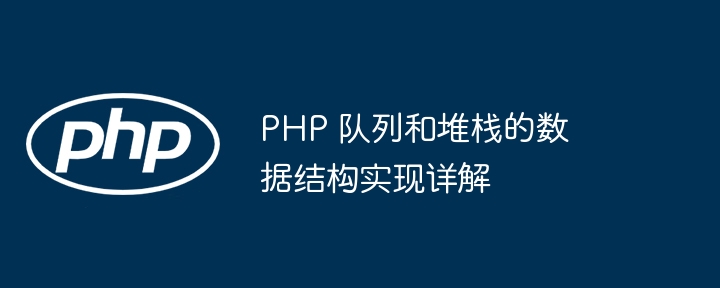 Backend Development
Backend Development
 PHP Tutorial
PHP Tutorial
 Detailed explanation of data structure implementation of PHP queue and stack
Detailed explanation of data structure implementation of PHP queue and stack
Detailed explanation of data structure implementation of PHP queue and stack
May 07, 2024 am 09:42 AMThe queue follows the "first in, first out" principle and can be implemented using an array or linked list; the stack follows the "last in first out" principle and can also be implemented using an array or linked list. Specific implementation methods include: queue array implementation, queue linked list implementation, stack array implementation, and stack linked list implementation. Practical cases demonstrate the application of queues and stacks in message printing and array reversal.

Detailed explanation of the data structure implementation of PHP queue and stack
Queue and stack are a common linear data structure. They possess unique properties and are widely used in a variety of applications. This article will introduce the data structure implementation of queues and stacks in PHP and provide practical cases.
Queue
The queue follows the "first in, first out" (FIFO) principle. The oldest inserted element in the queue will be removed first. Queues can be implemented using arrays or linked lists.
Array implementation:
class Queue
{
private $queue = [];
public function enqueue($item)
{
$this->queue[] = $item;
}
public function dequeue()
{
if (empty($this->queue)) {
throw new Exception("Queue is empty");
}
return array_shift($this->queue);
}
}Linked list implementation:
class Node
{
public $data;
public $next;
public function __construct($data)
{
$this->data = $data;
$this->next = null;
}
}
class Queue
{
private $head;
private $tail;
public function enqueue($item)
{
$node = new Node($item);
if (empty($this->head)) {
$this->head = $node;
$this->tail = $node;
} else {
$this->tail->next = $node;
$this->tail = $node;
}
}
public function dequeue()
{
if (empty($this->head)) {
throw new Exception("Queue is empty");
}
$item = $this->head->data;
$this->head = $this->head->next;
if (empty($this->head)) {
$this->tail = null;
}
return $item;
}
}Practical case: Use queue printing Message
$queue = new Queue();
$queue->enqueue("Hello");
$queue->enqueue("World");
while (!$queue->isEmpty()) {
echo $queue->dequeue() . "<br>";
}Stack
The stack follows the "last in, first out" (LIFO) principle. The last inserted element in the stack will be removed first. Stacks can be implemented using arrays or linked lists.
Array implementation:
class Stack
{
private $stack = [];
public function push($item)
{
$this->stack[] = $item;
}
public function pop()
{
if (empty($this->stack)) {
throw new Exception("Stack is empty");
}
return array_pop($this->stack);
}
}Linked list implementation:
class Node
{
public $data;
public $next;
public function __construct($data)
{
$this->data = $data;
$this->next = null;
}
}
class Stack
{
private $top;
public function push($item)
{
$node = new Node($item);
$node->next = $this->top;
$this->top = $node;
}
public function pop()
{
if (empty($this->top)) {
throw new Exception("Stack is empty");
}
$item = $this->top->data;
$this->top = $this->top->next;
return $item;
}
}Practical case: Use stack reverse order An array
$stack = new Stack();
$array = [1, 2, 3, 4, 5];
foreach ($array as $item) {
$stack->push($item);
}
$reversedArray = [];
while (!$stack->isEmpty()) {
$reversedArray[] = $stack->pop();
}
print_r($reversedArray);The above is the detailed content of Detailed explanation of data structure implementation of PHP queue and stack. For more information, please follow other related articles on the PHP Chinese website!

Hot Article

Hot tools Tags

Hot Article

Hot Article Tags

Notepad++7.3.1
Easy-to-use and free code editor

SublimeText3 Chinese version
Chinese version, very easy to use

Zend Studio 13.0.1
Powerful PHP integrated development environment

Dreamweaver CS6
Visual web development tools

SublimeText3 Mac version
God-level code editing software (SublimeText3)

Hot Topics
 PHP 8.4 Installation and Upgrade guide for Ubuntu and Debian
Dec 24, 2024 pm 04:42 PM
PHP 8.4 Installation and Upgrade guide for Ubuntu and Debian
Dec 24, 2024 pm 04:42 PM
PHP 8.4 Installation and Upgrade guide for Ubuntu and Debian
 How To Set Up Visual Studio Code (VS Code) for PHP Development
Dec 20, 2024 am 11:31 AM
How To Set Up Visual Studio Code (VS Code) for PHP Development
Dec 20, 2024 am 11:31 AM
How To Set Up Visual Studio Code (VS Code) for PHP Development












